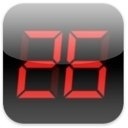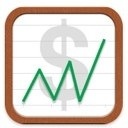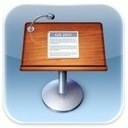In part one of this two part series on using an iPad at a conference, I examined three built-in apps I used most: Google Maps, Safari, and iCal. In this part, I’ll take a look at some of the others apps I used that helped me get more out of the recent JALT national conference in Nagoya.
 Time management with Presentation Clock
Time management with Presentation Clock
I gave two presentations and ran a staff meeting during the conference, and because time was so tight, it became essential to manage it well. The iPad version of Presentation Clock, by Shawn Welch, helped me do this. Costing a mere 115 yen, this simple single-function app allowed me to proceed without the stress of having to worry about time.
 When you start pClock up, you are given the ability to set a specific count-down timer and to indicate when the numbers change from green to yellow to red. For example, with my Animoto presentation with colleague Michael Stout, I set the timer to turn yellow at ten minutes and then red at five. By placing the iPad in front of us on a table, we could easily see it as we spoke. Yes, they had staff on hand to provide us time warnings, and yes, I suppose I could also have used a timer built-in to the presentation software I was using (Keynote), but still- there’s nothing like the security of seeing big, easy-to-read numbers.
When you start pClock up, you are given the ability to set a specific count-down timer and to indicate when the numbers change from green to yellow to red. For example, with my Animoto presentation with colleague Michael Stout, I set the timer to turn yellow at ten minutes and then red at five. By placing the iPad in front of us on a table, we could easily see it as we spoke. Yes, they had staff on hand to provide us time warnings, and yes, I suppose I could also have used a timer built-in to the presentation software I was using (Keynote), but still- there’s nothing like the security of seeing big, easy-to-read numbers.
Constant awareness of time allowed me to make subtle and in-the-moment decisions about content and pace. No matter how prepared you are, presentations are live events where unexpected things often expectedly occur. For example, during the Q&A of my presentation with Michael, one attendee asked a very deep philosophical question that challenged the premise of our talk. Knowing I had exactly 6:33 do deal with this provided a measure of comfort to properly manage the ensuing lively debate.
 Keeping track of expenses with Expense Tablet
Keeping track of expenses with Expense Tablet
It’s often the case that conference goers need to keep track of receipts. Such was the case for me. Along these lines a simple little app called Expense Tablet for iPad by Adam Williams (adamcode.com) really did the trick. The thing I liked best about this app was its elegant simplicity. It did exactly what I needed in a nice looking, easy-to-use way for a very good price. It was especially useful in keeping track of items I could get no receipt for, such as my share of party-going costs or vending machine drinks. There are numerous expense-tracking apps in the Finance section of the App Store, but most of them contain way more functionality than I need. I would therefore recommend Expense Tablet for anyone who just needs an inexpensive, simple, and elegant way of keeping track of money spent.
 Ideas for improvement
Ideas for improvement
In addition to improving the way I sync and share my calendar info, another area for improvement could be in actually using the Keynote for iPad app when giving my presentation. This would allow me to leave my MacBook Pro at home. This was the initial vision I had of conference going when I got the iPad back when I got it, but in reality, leaving my laptop at home has been more difficult than expected. Long story short, I’ve come to realize it takes a bit of time to get used to the iPad, to a new way of doing things. Yes, you can do productive things with it, but not in the same ways you can with your laptop (mainly due to lack of a keyboard). The complexity of my slide builds and the presence of embedded videos were too much for the iPad version of Keynote to handle. In addition, I wanted to be able to see my slides as I spoke, something that doesn’t happen on an iPad. With the iPad, you basically have a lightweight means for giving a basic presentation, but for something more robust, I still feel the need to use my MacBook Pro. Perhaps in time as the power and functionality of iPads and Keynote grows, then it will become a more viable option for me, and I’ll finally be free to leave that laptop at home.
Smooth sailing
In looking back over what I’ve written in these two posts on using an iPad at a conference, it’s clearer to me now why I seemed to get extra enjoyment out of the JALT national conference. At no point was I ever lost. I had total awareness of time and a means for managing it well. When I heard of some cool new website or came across a new term or concept, I just looked it up on the spot. If a speaker rambled, I was able to tune that out and focus instead on exploring the ideas they were trying to convey. Well-timed and appropriate multimedia access enhanced my social interactions in unique ways, and expense tracking meant that I always new where I stood financially. Even the friendly ribbing I got for always having my iPad in hand was fun as well. The iPad helped give me a greater feeling of control, and this in turn reduced unnecessary stress and allowed me to make better use of my mental and physical energy. Instead of running around dealing with some emergency, I could relax and enjoy the moment at hand, giving it my fullest attention. So instead of rushing off to the next thing, I could stop and enjoy a few solid moments of catching up with friends I often only see at this conference. It’s those little moments that add up to make for a successful and satisfying experience. With my iPad in hand, I had more than my average share of them.





